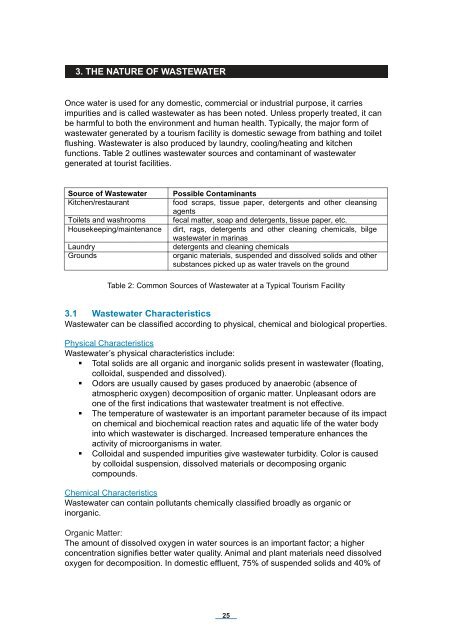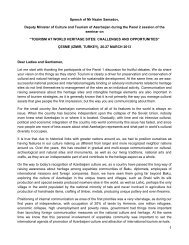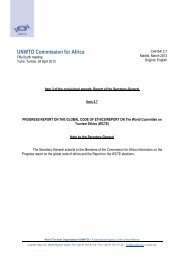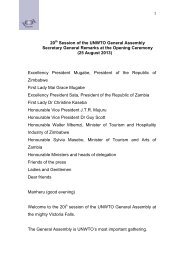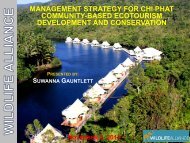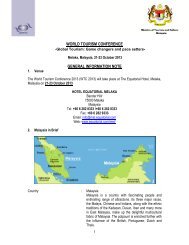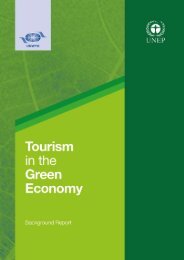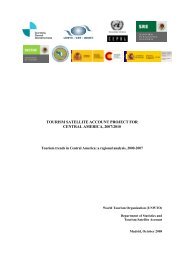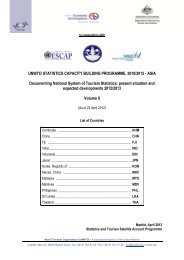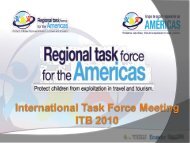A Manual for Water and Waste Management - World Tourism ...
A Manual for Water and Waste Management - World Tourism ...
A Manual for Water and Waste Management - World Tourism ...
You also want an ePaper? Increase the reach of your titles
YUMPU automatically turns print PDFs into web optimized ePapers that Google loves.
3. THE NATURE OF WASTEWATER<br />
Once water is used <strong>for</strong> any domestic, commercial or industrial purpose, it carries<br />
impurities <strong>and</strong> is called wastewater as has been noted. Unless properly treated, it can<br />
be harmful to both the environment <strong>and</strong> human health. Typically, the major <strong>for</strong>m of<br />
wastewater generated by a tourism facility is domestic sewage from bathing <strong>and</strong> toilet<br />
flushing. <strong>Waste</strong>water is also produced by laundry, cooling/heating <strong>and</strong> kitchen<br />
functions. Table 2 outlines wastewater sources <strong>and</strong> contaminant of wastewater<br />
generated at tourist facilities.<br />
Source of <strong>Waste</strong>water<br />
Kitchen/restaurant<br />
Toilets <strong>and</strong> washrooms<br />
Housekeeping/maintenance<br />
Laundry<br />
Grounds<br />
Possible Contaminants<br />
food scraps, tissue paper, detergents <strong>and</strong> other cleansing<br />
agents<br />
fecal matter, soap <strong>and</strong> detergents, tissue paper, etc.<br />
dirt, rags, detergents <strong>and</strong> other cleaning chemicals, bilge<br />
wastewater in marinas<br />
detergents <strong>and</strong> cleaning chemicals<br />
organic materials, suspended <strong>and</strong> dissolved solids <strong>and</strong> other<br />
substances picked up as water travels on the ground<br />
Table 2: Common Sources of <strong>Waste</strong>water at a Typical <strong>Tourism</strong> Facility<br />
3.1 <strong>Waste</strong>water Characteristics<br />
<strong>Waste</strong>water can be classified according to physical, chemical <strong>and</strong> biological properties.<br />
Physical Characteristics<br />
<strong>Waste</strong>water’s physical characteristics include:<br />
Total solids are all organic <strong>and</strong> inorganic solids present in wastewater (floating,<br />
colloidal, suspended <strong>and</strong> dissolved).<br />
Odors are usually caused by gases produced by anaerobic (absence of<br />
atmospheric oxygen) decomposition of organic matter. Unpleasant odors are<br />
one of the first indications that wastewater treatment is not effective.<br />
The temperature of wastewater is an important parameter because of its impact<br />
on chemical <strong>and</strong> biochemical reaction rates <strong>and</strong> aquatic life of the water body<br />
into which wastewater is discharged. Increased temperature enhances the<br />
activity of microorganisms in water.<br />
Colloidal <strong>and</strong> suspended impurities give wastewater turbidity. Color is caused<br />
by colloidal suspension, dissolved materials or decomposing organic<br />
compounds.<br />
Chemical Characteristics<br />
<strong>Waste</strong>water can contain pollutants chemically classified broadly as organic or<br />
inorganic.<br />
Organic Matter:<br />
The amount of dissolved oxygen in water sources is an important factor; a higher<br />
concentration signifies better water quality. Animal <strong>and</strong> plant materials need dissolved<br />
oxygen <strong>for</strong> decomposition. In domestic effluent, 75% of suspended solids <strong>and</strong> 40% of<br />
25


